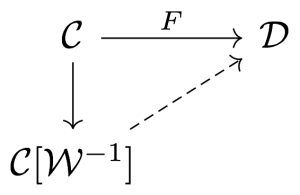As we know, cohomology of sheaves on affine schemes is boring. The next simplest case we can consider is sheaves on projective schemes.
7. The  construction
construction
We can define projective space by gluing affine space together, but there is a more canonical construction. By a graded ring  , we implicitly assume that
, we implicitly assume that  .
.
Definition 1. The scheme

is defined as the following. A point in

is a homogeneous prime ideal

of

such that

doesn’t contain all of

. The topology is generated by the sets

for homogeneous

with

, and the structure sheaf on

is given by the

of the

-th graded piece

.
Example 1. If
![{S = A[x_0, \ldots, x_n]}](https://s0.wp.com/latex.php?latex=%7BS+%3D+A%5Bx_0%2C+%5Cldots%2C+x_n%5D%7D&bg=ffffff&fg=000000&s=0&c=20201002)
, we have

.
So any kind of section needs to come from a  -th graded element in the ring. This makes sense, because on projective space, functions like
-th graded element in the ring. This makes sense, because on projective space, functions like  or
or  don’t give well-defined values. On affine schemes, we were able to construct sheaves on
don’t give well-defined values. On affine schemes, we were able to construct sheaves on  from
from  -modules. Similarly, we can construct sheaves on
-modules. Similarly, we can construct sheaves on  from graded
from graded  -modules.
-modules.
Definition 2. Let

be a graded ring, and let

be a graded

-module. We define a quasi-coherent sheaf

on

, so that

.
The sheaves are glued via, where  and
and  , the isomorphisms
, the isomorphisms  . We immediately see that this is a quasi-coherent sheaf on
. We immediately see that this is a quasi-coherent sheaf on  . Of course, this construction is functorial in
. Of course, this construction is functorial in  , and a short exact sequence
, and a short exact sequence  induces an exact sequence
induces an exact sequence

of quasi-coherent sheaves, because the construction is exact affine-locally. Continue reading “Faisceaux Algébriques Cohérents III – Coherent sheaves on projective space” →


